Visit Paigah Tombs To Explore The History Of Hyderabad

The Paigah Tombs are a grand monument located in Hyderabad, India. These tombs were built to honour the Paigah nobles, courtiers and administrators during Nizam’s rule. The tombs stand out with their elegant architecture, featuring intricately carved domes, arches, and latticed windows. Beautiful gardens surround the entire complex, adding to its serene ambience. Visiting the Paigah Tombs transports you back in time, allowing you to marvel at the grandeur and artistry of the Paigah dynasty. It’s a must-visit destination for anyone interested in history and architecture or simply seeking a peaceful retreat within the bustling city of Hyderabad.
An Overview About Paigah Tombs
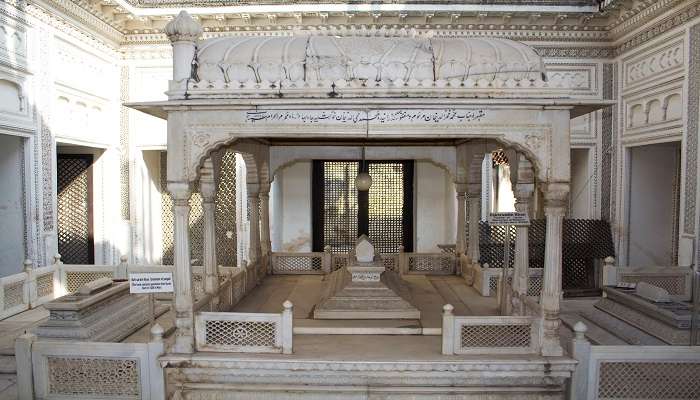
The Paigah Tombs, also known as Maqhbara Shams al-Umara, is a collection of mausoleums dedicated to the Paigah family, who served as nobles, statesmen, philanthropists, and generals under the Nizams of Hyderabad. These tombs are considered one of Hyderabad’s major architectural marvels.
Built in the 18th century, the Paigah Tombs are a unique mix of architectural styles, including Mughal, Persian, Moorish, Byzantine, Rajasthani, and Deccani influences. The tombs are constructed from lime, marble, and mortar and feature intricate carvings, beautiful pillars, ornate trelliswork, and embellished domes. The complex is spread over 35-40 acres.
Must Read: Waterfalls Near Hyderabad
History Of Paigah Tombs
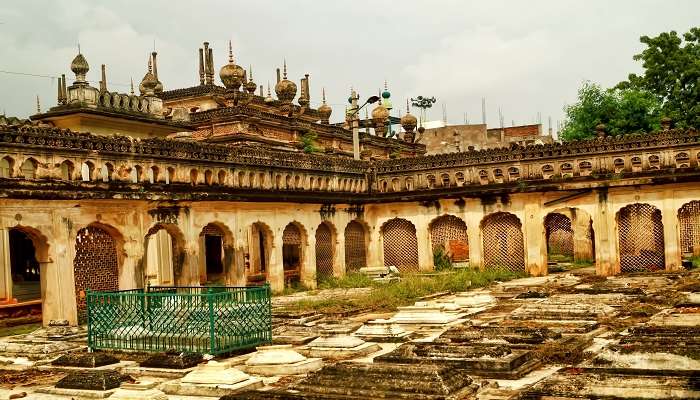
During the 18th century, the Paigah noble families rose to prominence within the aristocracy of the Princely State of Hyderabad, tracing their lineage to Omar bin Al-Khattab, the second caliph of Islam. Spanning an impressive 4000 sq. miles, their territories were managed through Jagirs. Abdul Fateh Khan Tegh Jung, their esteemed ancestor, accompanied Asaf Jah 1st to the Deccan and laid the foundation of the Paigah nobility. Notably, Abdul Fateh Khan Tegh Jung earned distinction for his service to the second Nizam, securing the prestigious position of Commander in Chief with the title Shams-ul-Umra, signifying his elevated status among the nobles.
The tombs were initially constructed by Amir e Kabir I, with detailed accounts in the Viceroy’s diary and a letter from Resident J.C. Bayley to Nawab Salar Jung, the then-prime minister. This letter, dated 10 March 1882, provides essential details about the tombs following the death of the Co-Regent and Amir E Kabir III, Nawab Rashid uddin Khan Bahadur. Bayley suggested that the three Paigahs—Nawab Sir Asman Jah Bahadur, Sir Khurshid Jah, and Sir Vikar Ul Umra—perform the Urs ceremony for their grandfather and great-grandfather simultaneously to maintain protocol and avoid disputes over precedence.
Architecture Of Paigah Tombs
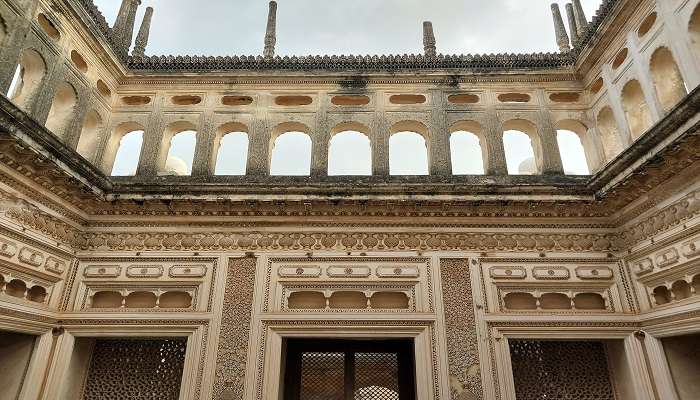
The Paigah Tombs in Hyderabad is an architectural marvel, showcasing Mughal and Moorish styles in a unique synthesis. The crypts, constructed from lime and mortar, feature intricate marble inlay work and stucco reminiscent of Granada and Seville in Spain. These magnificent structures are adorned with stucco work and showcase an extraordinary amalgamation of Moghal, Greek, Persian, Asaf Jahi, Rajasthani, and Deccani architectural styles. The artistry is especially evident in the exquisitely inlaid mosaic work and the unique geometrical designs perforated with screens, demonstrating remarkable craftsmanship.
With each step, the mausoleum unveils exquisite craftsmanship, from intricately carved canopies to marble-inlaid floral motifs, showcasing the unparalleled skill of artisans. What captivates most is the unique touch evident in every aspect; no design is replicated, inviting exploration and marvel at the subtle nuances of each Paigah noble’s final resting place. The tombs are a treasure trove of intricate latticework, particularly showcased in delicately carved wooden doors and jaali screens, leaving visitors in awe of the meticulous craftsmanship.
Suggested Read: Amazing Places Near Hyderabad
Interesting Facts About Paigah Tombs
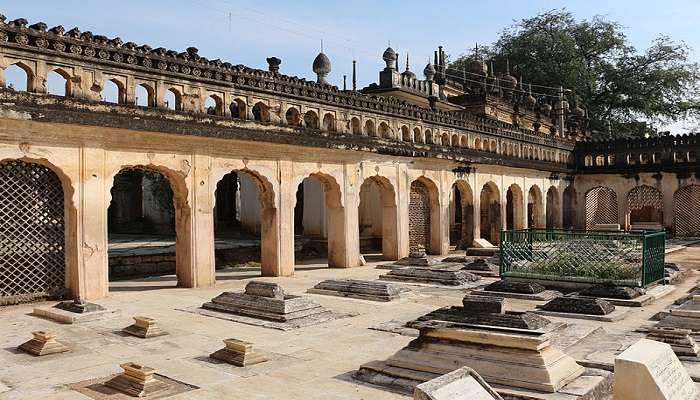
The Paigah family left a rich legacy, and their tombs are a testament to their prominence in Hyderabad’s history. Some of the exciting facts about the Paigah Tombs:
- These tombs are particularly popular among visitors, likely due to their historical significance or architectural beauty.
- Over 100 tombs spread across the site serve as the final resting place for numerous members of the Paigah family.
- The tombs were once adorned with precious and semi-precious stones, which had the unique characteristic of changing colour with the seasons, adding to their allure and beauty.
- Intricate designs on the walls depict royal symbols such as fruits, serpents, vases, and drums, reflecting the luxury and status of the Paigah family.
- The Paigah Tombs cover a vast area of 35-40 acres, with a specific area of around 2 acres dedicated to the tombs of Paigahs who married the daughters of the Nizam. The remaining area contains tombs of other Paigah family members.
Timings, Entrance Fees, and Best Time to Visit
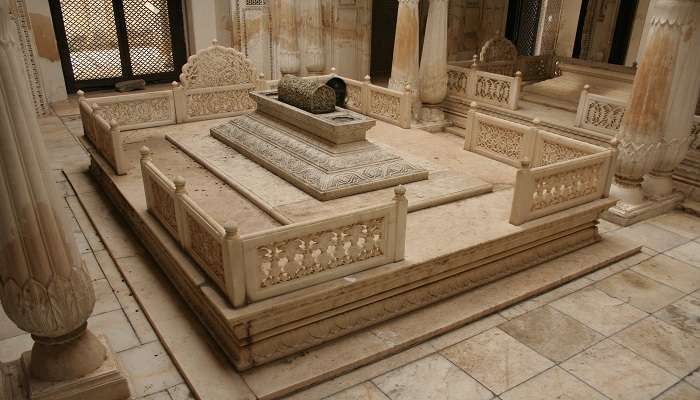
The Paigah Tombs, with no entry fee, welcome visitors from Monday to Sunday between 10:00 AM and 5:00 PM. The best time to visit is from November to February, during the cooler months of Hyderabad’s winter. With pleasant weather and comfortable temperatures, visitors can explore the tombs’ intricate designs and historical significance without the discomfort of extreme heat.
Suggested Read: Places To Visit In Hyderabad At Night
How To Reach
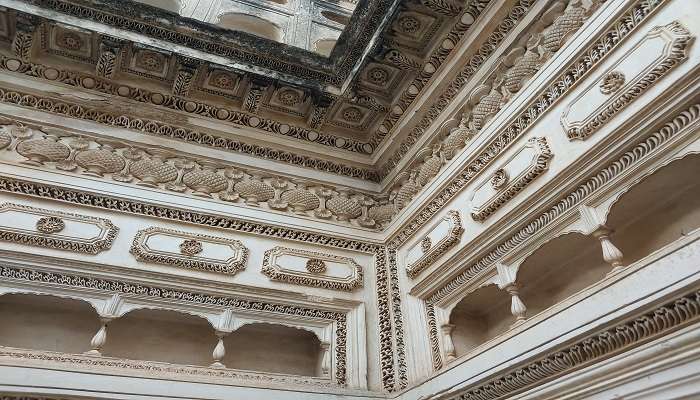
The most convenient way to reach the Paigah Tombs from the airport is by hiring a private taxi or cab. Depending on traffic conditions, this option provides a direct and comfortable journey, taking approximately 45 minutes to an hour. The typical route from the airport involves taking the Airport Approach Road and merging onto NH 44. Continue on NH 44, then take the exit towards the PV Narasimha Rao Expressway. Follow the expressway, and then merge onto Inner Ring Road. From Inner Ring Road, head towards Dilsukh Nagar and then onto the Madannapet area, where the tombs are located.
One can also take the airport shuttle to the nearest metro station, Raidurg, and then travel to a central metro station like Ameerpet. From Ameerpet, transfer to another metro line heading towards MG Bus Station. Take a local bus or auto-rickshaw from MG Bus Station to the Paigah Tombs. Additionally, one can take the Pushpak Airport Liner from the airport to a major bus stop such as Secunderabad or MGBS (Mahatma Gandhi Bus Station). From there, board a local bus heading towards the Santosh Nagar or Saidabad area. Check the bus numbers and routes with the local transport authorities or online.
Further Read: Weekend Getaways From Hyderabad
The Paigah Tombs are a beautiful part of Hyderabad’s rich cultural history. Decorated with detailed carvings and designs, these tombs give a fascinating look into the city’s past. Whether you love history or just want to see the grandeur of old times, visiting the Paigah Tombs is a must. Take a trip to Hyderabad and discover the secrets of this amazing city. Book your trip to Hyderabad and let the Paigah Tombs transport you to a world of timeless beauty and cultural splendour.
For our editorial codes of conduct and copyright disclaimer, please click here.
Cover Image Credit: Shutterstock
Frequently Asked Questions About Paigah Tombs
Who built Paigah Tombs?
The Paigah Tombs were constructed by a noble from the Paigah family, Amir-e-Kabir H.E. Nawab Sir Khursheed Jah Bahadur. The tombs are a testament to the loyalty of the Paigah family to the Nizams, serving as their final resting place over several generations.
What is the meaning of Paigah?
“Paigah,” a Persian word, translates to “pomp and rank.” The second Nizam of Hyderabad bestowed this title upon Nawab Abu’l Fateh Khan Tegh Jung Bahadur in recognition of his royal services.
Who were the Paigahs of the Deccan?
The Paigahs were a noble lineage from the erstwhile Hyderabad State. They held their court, owned individual palaces, and commanded an army of approximately fourteen thousand troops. The founder of this noble house was Nawab Abu’l Fateh Khan Tegh Jung Bahadur, also known as Shams-ul-Umra I. The Paigahs arrived in the Deccan with Emperor Aurangzeb during his region conquest.
What is the restoration project for Paigah Tombs?
The United States government is providing $250,000 to support the conservation and restoration of six of the Paigah tombs, built in the 18th and 19th centuries. The US Ambassadors Fund for Cultural Preservation (AFCP) facilitates the project and is funded by the US Consulate in Hyderabad. The Aga Khan Trust for Culture (AKTC) is tasked with implementing the project.
What was the ruler of Hyderabad Deccan called?
The ruler of Hyderabad Deccan bore the title of the Nizam. The Nizam ruled the state from 1724 to 1857, initially as a ruler of the Mughal empire in the Deccan. The Asaf Jahi dynasty was established by Mir Qamar-ud-Din Siddiqi (Asaf Jah I), who served as a Nizam of the Deccan sultanates under the Mughal Empire from 1713 to 1721.
People Also Read:
Safdarjung Tomb Ibbankatuwa Megalithic Tombs Humayun Tomb

With a passion for exploring and travelling to the roads long forgotten, experience the world through enthralling stories and adventures. Join me as I share my experiences at some of the world’s most popular tourist destinations and quench that pestering curiosity with something exciting!











